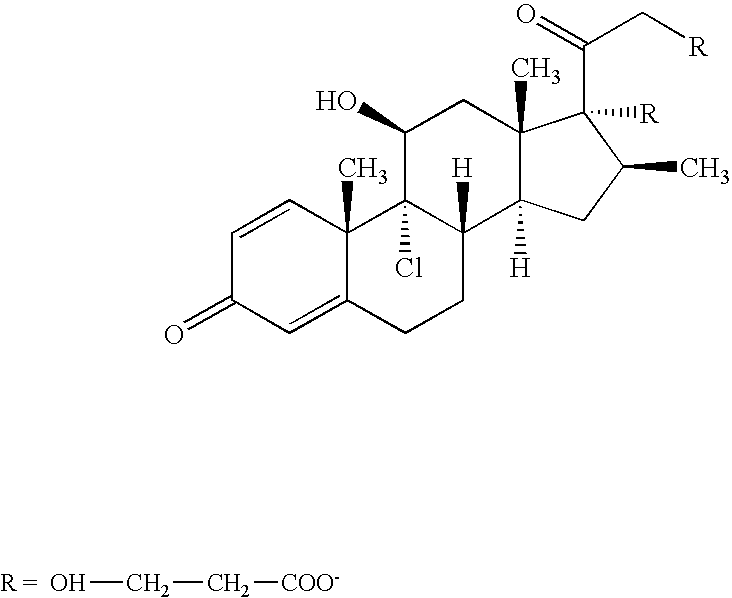Topically active steroids for use in radiation and chemotherapeutics injury
a technology of radiation and chemotherapeutics, applied in the direction of metabolism disorders, extracellular fluid disorders, peptide/protein ingredients, etc., can solve the problems of gastrointestinal symptoms, chronic conditions including mucositis, enteritis, and proctitis, and achieve the effect of preventing or reducing the severity of cellular damag
- Summary
- Abstract
- Description
- Claims
- Application Information
AI Technical Summary
Benefits of technology
Problems solved by technology
Method used
Image
Examples
example 1
Supportive Care with Antibiotic Therapy and Treatment of the Hematopoietic Compartment after Irradiation in Dogs
[0072]The dog is a particularly suitable animal model for studying radiations damage to epithelial tissue. Death from the GI radiation syndrome was observed in dogs that were given myeloablative unfractionated total body irradiation (TBI) at a high dose rate (either 0.4 or 0.7 Gy / min). To evaluate the response to TBI given at the high dose rate of 0.4 Gy / min or 0.7 Gy / min, treatment groups were given single-fraction 6, 7, 8 or 10 Gy TBI and received previously cryopreserved autologous marrow infusion upon completion of the TBI and standard supportive care. At doses of TBI below 8 Gy, all dogs survived. After 8 Gy TBI, 5 of 9 dogs died and after 10 Gy TBI, 9 of 9 dogs died from GI radiation syndrome. All deaths occurred between days 4 to day 6 after 10 Gy TBI. All deaths were attributable due to GI radiation toxicity with severe gut hemorrhage and intestinal crypt damage, a...
example 2
Treatment of Radiation Injury with KGF
[0080]The canine KGF gene has been cloned and sequenced. RhKGF has 97.4% amino acid sequence homology to canine KGF. The murine KGF protein has 94% homology to rhKGF. In addition, the KGF receptor (FGFR2IIIb) has 98% homology between all three species. RhKGF was used for all of the in vivo murine studies described above. rhKGF has equivalent biologic activity in dogs. RhKGF has a gut epithelial cytoprotective activity in the dog. KGF treatment decreases gut, thymic and bone marrow stromal epithelial damage from radiation, thereby improving survival after TBI induced GI toxicity and pancytopenia with more rapid intestinal epithelium recovery and immune reconstitution.
[0081]Three non-irradiated dogs were given rhKGF 100 μg / kg / day for 7, 14 and 21 days, respectively. Twenty-four hours after the last dose of KGF, dogs were euthanized and underwent complete necropsy. Among the dogs that received KGF for 14 and 21 days, there was a dramatic increase i...
example 3
Treatment of Radiation Injury with BDP
[0083]As in example 2, BDP was given at a dose of 4 mg / day from 2 hours after TBI until GI recovery and the same experimental endpoints were monitored. BDP provided greater than 70% survival.
PUM
| Property | Measurement | Unit |
|---|---|---|
| body weight | aaaaa | aaaaa |
| body weight | aaaaa | aaaaa |
| concentrations | aaaaa | aaaaa |
Abstract
Description
Claims
Application Information
 Login to View More
Login to View More - R&D
- Intellectual Property
- Life Sciences
- Materials
- Tech Scout
- Unparalleled Data Quality
- Higher Quality Content
- 60% Fewer Hallucinations
Browse by: Latest US Patents, China's latest patents, Technical Efficacy Thesaurus, Application Domain, Technology Topic, Popular Technical Reports.
© 2025 PatSnap. All rights reserved.Legal|Privacy policy|Modern Slavery Act Transparency Statement|Sitemap|About US| Contact US: help@patsnap.com

